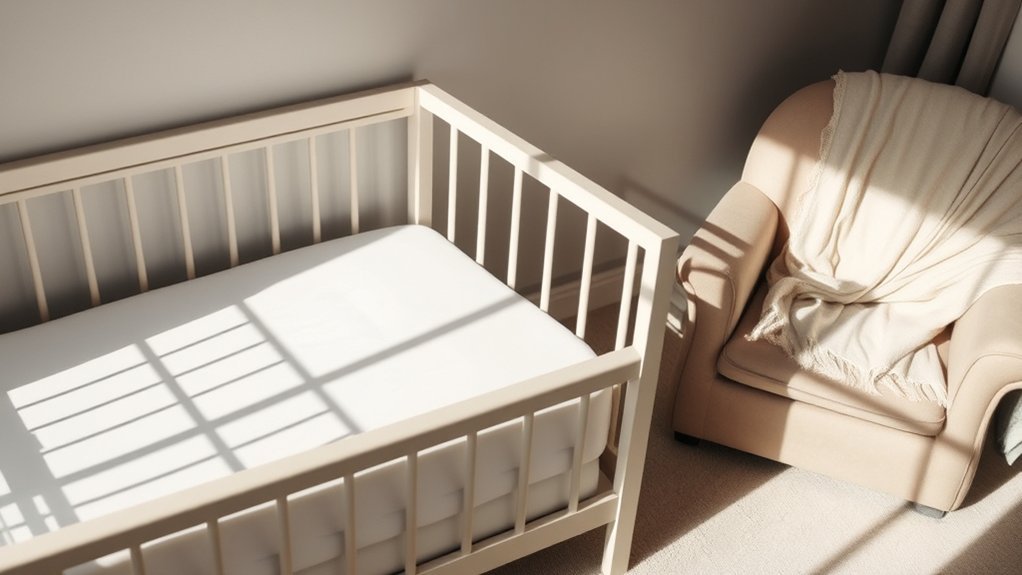When it comes to your baby’s sleep surface safety, you probably have many questions. Choosing the right crib, ensuring a firm mattress, and avoiding soft bedding are critical factors. You might wonder when it’s safe to shift your child from a crib to a bed or how to eliminate potential hazards in their sleep area. Understanding these aspects can make a significant difference in your child’s safety and well-being. Let’s explore these essential concerns further.
What Type of Crib Should I Choose for My Baby?
When choosing a crib for your baby, what features should you prioritize to guarantee safety and comfort?
First, look for cribs that meet current safety standards, ensuring they’re free from sharp edges and toxic materials. A sturdy construction is essential; solid wood is often a reliable choice.
Prioritize cribs that meet safety standards and feature sturdy construction, ideally made from solid wood.
Adjustable mattress heights allow you to lower the mattress as your baby grows, enhancing safety. Choose a crib with slats no more than 2-3 inches apart to prevent entrapment.
Consider a crib that converts into a toddler bed, promoting longevity and value. Finally, avoid cribs with drop-side rails, as these pose safety risks.
How Firm Should a Mattress Be for Infant Sleep?
Choosing the right crib is just the beginning; the mattress you select plays an essential role in your baby’s sleep safety and comfort.
For infants, a firm mattress is vital. A mattress that’s too soft can pose serious risks, including the potential for suffocation. It’s important to verify the mattress fits snugly within the crib, with no gaps that could trap your baby.
When choosing a mattress, look for options labeled as “firm” or “extra firm.” You should be able to press down on the surface and feel minimal give.
What Are the Risks Associated With Soft Bedding?
While soft bedding might seem cozy and inviting, it greatly increases the risk of suffocation and other hazards for infants.
Soft mattresses, pillows, and comforters can create dangerous situations, as they may conform to your baby’s face, obstructing airflow. This can lead to a higher risk of sudden infant death syndrome (SIDS).
Furthermore, plush items can shift unexpectedly, leaving your child at risk of entrapment.
To promote a safer sleep environment, use a firm mattress with a fitted sheet and keep the crib free from soft toys, blankets, and excess bedding.
When Can My Child Transition From a Crib to a Bed?
How do you know it’s the right time for your child to shift from a crib to a bed? Generally, you should consider changing when your child is at least 2 years old, can climb out of the crib, or shows interest in sleeping in a bed. Each child is unique, so assess their readiness based on these factors:
| Signs of Readiness | Considerations |
|---|---|
| Child is 2 years or older | Safety of the new bed |
| Climbing out of the crib | Room layout and accessibility |
| Expressing interest in beds | Comfort with the change |
| Sleep patterns changing | Potential nighttime safety risks |
How Can I Ensure My Baby’s Sleep Area Is Free From Hazards?
What steps can you take to keep your baby’s sleep area safe from hazards?
Start by choosing a firm mattress that fits snugly in the crib or bed without gaps. Remove all soft bedding, pillows, and toys, as these can pose suffocation risks.
Choose a firm mattress that fits snugly in the crib, and eliminate soft bedding, pillows, and toys to ensure safety.
Verify that the crib meets current safety standards and hasn’t been recalled. Keep the sleep area free from cords, blinds, and other potential strangulation hazards. Regularly check for any loose screws or broken parts.
Maintain a comfortable temperature, avoiding overheating by dressing your baby in light clothing.
Finally, always place your baby on their back to sleep, which is a proven strategy to reduce the risk of sudden infant death syndrome (SIDS). Your vigilance guarantees a safer sleep environment.
Frequently Asked Questions
What Materials Are Safest for Crib Mattresses?
The safest materials for crib mattresses include organic cotton, natural latex, and non-toxic foam. These materials minimize harmful chemicals, promoting a healthier sleep environment for your baby while ensuring comfort and support during rest.
How Often Should I Replace My Baby’s Mattress?
You should replace your baby’s mattress every 3 to 5 years. Just like a trusty steed deserves fresh shoes, your little one’s sleep surface needs renewal for ideal support and safety as they grow.
Can I Use a Secondhand Crib Safely?
You can use a secondhand crib safely if it’s in good condition, meets current safety standards, and lacks recalls. Always check for any wear, loose parts, or damage before placing your baby inside.
What Sleep Accessories Are Safe for Infants?
You’ll want to stick to essential items like firm mattresses, fitted sheets, and breathable swaddles. Avoid soft toys and heavy blankets; they can pose risks. Prioritize safety, and you’ll guarantee a peaceful sleep for your infant.
How Can I Tell if My Baby’s Mattress Is Too Worn?
Check for sagging, lumps, or tears on your baby’s mattress. If it feels uneven or doesn’t bounce back, it’s too worn. Regularly inspect it to guarantee your baby’s sleep environment remains safe and supportive.
Conclusion
To summarize, ensuring your baby’s sleep surface is safe is crucial for their well-being. Did you know that placing your baby on their back to sleep can reduce the risk of SIDS by up to 50%? By choosing a firm mattress, avoiding soft bedding, and ensuring a snug crib fit, you’re taking essential steps to protect your little one. Stay informed and vigilant about sleep safety, as these simple measures can make a significant difference in your baby’s health.
